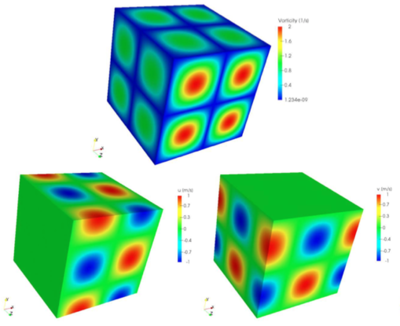Step 2
Step 2 Description
The next step in the benchmark is to simulate the Taylor-Green Vortex configuration in 3-D, still for a single-component incompressible flow. For this configuration, a reference solution obtained with a pseudo-spectral solver is available in the scientific literature[1] and can be used for validation by a direct comparison.
The domain size has been set to in each direction, where is an arbitrarily-chosen reference length scale for dimensional codes. As in the previous section, periodic boundary conditions are used in all three spatial directions.
The initial conditions for 3-D TGV are given by the following set of equations:
(1)
(2)
(3)
The reference velocity magnitude is set again to . The desired Reynolds number is again , as in the previous section, since this value has been used as well in the reference study employed for comparison[1]. To obtain the proper value of Re, the kinematic viscosity is set once again to . With this set of parameters, the reference time scale is . The flow simulation must be carried out for a physical time of .
Regarding spatial discretization, a resolution of at least 512 nodes (or cells) in each direction is recommended. This value leads to an over-resolved simulation during the first few but is necessary to capture properly the transition to turbulence that should occur between 10 and 15 . As a point of comparison, the reference solution from[1] has been obtained with a spectral code on a grid. The timestep should be chosen to ensure that the maximum values of the Courant-Friedrichs-Lewy (CFL) and Fourier (Fo) numbers remain below and , respectively. This values are actually quite conservative since the focus of this study is set on accuracy comparisons and not on pure computational performance.
2D Large-Eddy Simulation, injection of a premixed kerosene/air mixture on the left with a high level of turbulence. Some kerosene droplets are added to this premixing.
On the other hand, considering that implementing advanced models for fluid viscosity and thermal conductivity is not difficult and does not increase the computational time significantly, local values of these quantities depending on composition and temperature should be taken into account.
You can observe below the initial fields of the velocity components and of the vorticity. Those fields are decribed thanks to the equations (1), (2) and (2).
Here is a video showing the phenomenon of step 2.
Aside Suggestion
Check mesh convergence and time integration independence.
Check that
References
- van Rees WM, Leonard A, Pullin D, Koumoutsakos P. A comparison of vortex and pseudo-spectral methods for the simulation of periodic vortical flows at high reynolds numbers. J Comput Phys. 2011;230(8):2794-2805.
- Carton de Wiart C, Hillewaert K, Duponcheel M, Winckelmans G. Assessment of a discontinuous galerkin method for the simulation of vortical flows at high reynolds number. Int J Numer Meth Fluids. 2014;74(7):469-493.
- Duponcheel M, Orlandi P, Winckelmans G. Time-reversibility of the euler equations as a benchmark for energy conserving schemes. J Comput Phys. 2008;227(19):8736-8752.
- Bricteux, L, Zeoli, S, Bourgeois, N. Validation and scalability of an open source parallel flow solver. Concurrency Computat: Pract Exper. 2017; 29:e4330. https://doi.org/10.1002/cpe.4330
